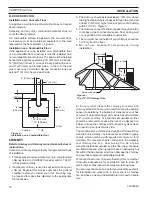
VSW40 Wood Stove
60300060
7
STOVE SET-UP
Masonry Chimney
Although masonry is the traditional material used for
chimney construction, it can have distinct performance
disadvantages when used to vent a controlled combustion
wood stove. Masonry forms an effective “heat sink”—that
is, it absorbs and holds heat for long periods of time.
The large mass however, may take a long time to become
hot enough to sustain a strong draft. The larger the
chimney (in total mass) the longer it will take to warm up.
Cold masonry will actually cool exhaust gases enough
to diminish draft strength. This problem is worse if the
chimney is located outside the home or if the chimney
flue has a cross-sectional volume much larger than the
stove outlet.
Pipe and Chimney Layout
Every bend in the flue will act as a brake on the exhaust
as it flows from the firebox to the chimney cap. The ideal
pipe and chimney layout is straight up from the stove
through completely straight chimney. Use this layout if at
all possible, as it will promote optimum stove performance
and simplify maintenance.
If the stovepipe must elbow to enter a chimney, locate
the elbow about midway between the stovetop and the
chimney thimble. This configuration lets the smoke speed
up before it must turn, keeps some pipe in the room for
heat transfer, and allows long-term flexibility for installing
a different appliance without relocating the thimble. There
should be no more than eight feet of single-wall stove pipe
between the stove and a chimney. Longer runs can cool
the smoke enough to cause draft and creosote problems.
Use double-wall stove pipe for longer runs.
Single Venting
Your stove requires a dedicated flue. Do not connect the
stove to a flue used by any other appliance. Chimney draft
is a natural form of energy and follows the path of least
resistance. If the stove is vented to a flue that also serves
open replace or another appliance, the draft will also pull
air through those avenues.
The additional airflow will lower the flue temperatures,
reduce draft strength and promote creosote development;
overall stove performance will suffer. The effect is similar to
that of a vacuum cleaner with a hole in the hose. In some
extreme instances, the other appliances can even impose
a negative draft and result in a dangerous draft reversal.






































